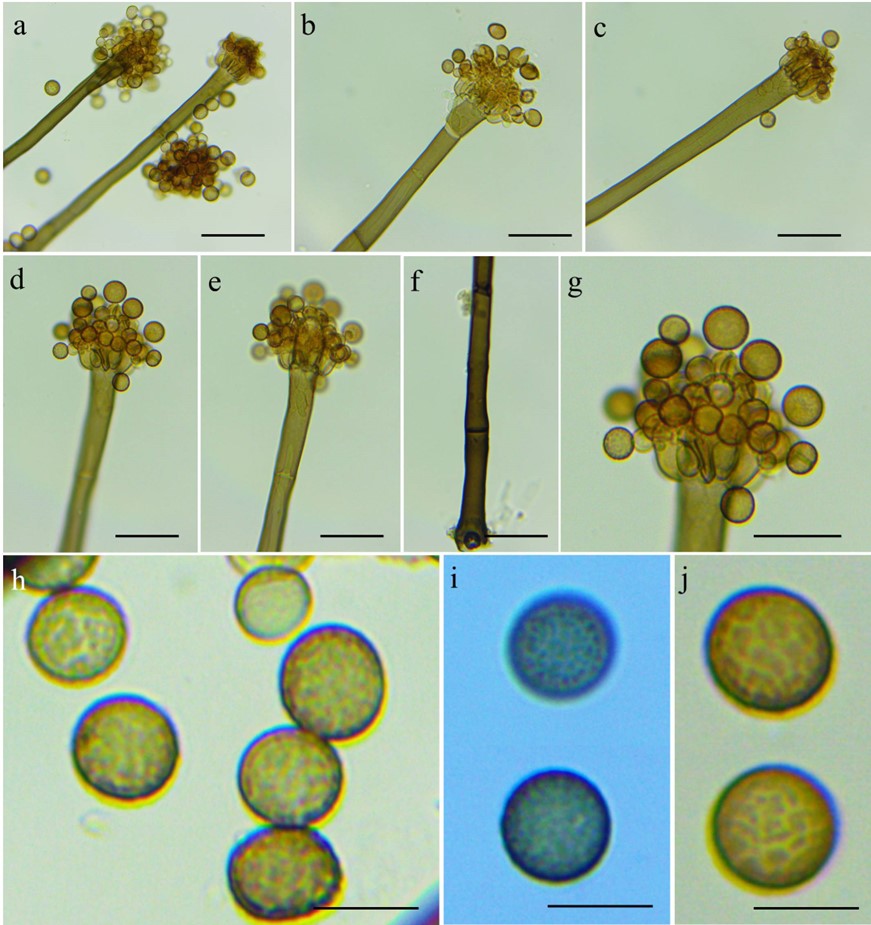Periconia byssoides Pers., Syn. meth. fung. (Göttingen) 2: 686 (1801)
MycoBank number: MB 144538; Index Fungorum number: IF 144538; Facesoffungi number: FoF 09319; Fig. **
Saprobic on leaves of Vigna unguiculata (L.) Walp. Sexual morph: Undetermined. Asexual morph: Conidiophores with conidial heads were observed on foliar lesions of cowpea. Conidiophores observed after 2-3 weeks, simple, micro- and semi-macronematous, unbranched and branched, initially subhyaline to brownish, verruculose, and variable in length. Conidiogenous cells discrete, determinate, terminal or lateral, subglobose, mono- and polyblastic, smooth to verruculose, pale brown producing global verrucose conidia in acropetal chains (3–4 in number), 11.5–12.5 × 15−17 μm diam., conidia pale brown to brown verrucose. Conidiogenous cells were formed on an apical cell and in the collar region around the septa, sometimes on short hyaline or subhyaline branchlets. From primary, hyaline, globose conidiogenous cells numerous secondary conidiogenous cells arise, which produce short chains of spherical, commonly verruculose but sometimes verrucose, pale brown to brown conidia, 8.5–11.4 μm diam.
Cultural characteristics: Culture on MEA reaching 35 mm after 20 days at 25 °C. Fungal colony appeared cottony with abundant white to orange-white aerial mycelium. In reverse colony dark olive to dark olivaceous-grey with concentric dark olivaceous-brown. Hyphae hyaline sometime greyish green, smooth and verruculose later becomes brown orange.
Material examined: INDIA, Karnataka, Mysore, Doddamaragowdanahally, on foliar lesions of Vigna unguiculata (Cowpea) 18 May 2020 Mahadevakumar and Deepika (Specimen UOM-IOE 18/21).
Distribution: Luthiana (Italy), Mysore (India)
Hosts: Heracleum sosnowskyi, Angelica sylvestris L., Conium maculatum L. (Apiaceae) (Markovskaja and Kačergius, 2013); Vigna unguiculata (L.) Walp. (present study).
GenBank Accession number: ITS: OM811496; LSU: OM811504
Notes: Detail description and illustration presented in Masson and Ellis (1953) and Markovskaja and Kačergius (2013). Morphological examination, measurements of conidiophores and conidia revealed that the fungal specimens reported by Markovskaja and Kačergius in 2013 various hosts of Apiaceae family are agreed well with the P. byssoides which was based on lectotype material, the protologue (Fries 1832). This is the first time that P. byssoides is reported from Fabaceae namely, Vigna unguiculata representing a new host record and geographical record.
Table 1: Comparative account of Periconia species with P. byssoides recorded on Cowpea from India
| Species | Conidiophores | Conidia | Color | Habit | Reference |
| Periconia byssoides | Macronematous and proliferating with elongate apical cell and with branchlets | Spherical, verrucose; 8.5 – 14.4 (18.2) µm in diam. | Pale brown to brown | On cowpea leaves | Present study |
| Periconia byssoides
(Mason and Ellis 1953; Ellis 1971; Matsushima 1975) |
Macronematous and proliferating with elongate apical cell and with branchlets | Spherical, verrucose; 10 – 12 (17) µm in diam. | Pale brown to brown | Terrestrial saprobe | Markovskaja and Kačergius 2014 |
| Periconia pseudobyssoides
(Markovskaja and Kačergius 2014) |
Macronematous, with numerous proliferations and swollen apical cell without branchlets | Spherical to verrucose (12)15-17(20) µm in diam. | Golden brown to reddish brown | Terrestrial saprobe | Markovskaja and Kačergius 2014 |
| Periconia cookei
(Mason and Ellis 1953; Ellis 1971) |
Macronematous and proliferations and swollen apex with without apical cell | Spherical, verrucose 13 – 16 µm in diam. | Brown to dark brown | Terrestrial saprobe | Markovskaja and Kačergius 2014 |
| Periconia shyamala
(Ellis 1971; Storey 2002) |
Macronematous with elongate apical cell and branchlets | Spherical, verrucose 13 – 16(18)-22(25) µm in diam. | Brown to dark brown | Terrestrial parasite or saprobe | Markovskaja and Kačergius 2014 |
| Periconia typhicola
(Ellis 1976) |
Macronematous branched inside the head | Spherical, verrucose; 11 – 17 µm in diam. | Pale brown to brown | Terrestrial saprobe | Markovskaja and Kačergius 2014 |
| Periconia prolifica
(Anastasiou 1963; Vrijmoed et al. 1982) |
Micronematous, semimicronematous with proliferations | Subglobose, smooth, 7.5-15 µm in diam. | Subhyaline to pale brown | Marine saprobe | Markovskaja and Kačergius 2014 |

Figure 1: Cowpea leaves showing the growth of Periconia byssoides on the necrotized lesions.

Periconia byssoides associated with cowpea: a – c – Conidiophores terminating with heads of conidia; d – e – heads of conidia showing phialides; f – basal part of conidiophores showing their distinct nature (color and septa); g – close view of the conidial head showing conidia and phialides; h – j – Conidia enlarged (Scale: a-g 50µm; h-j – 20µm).
